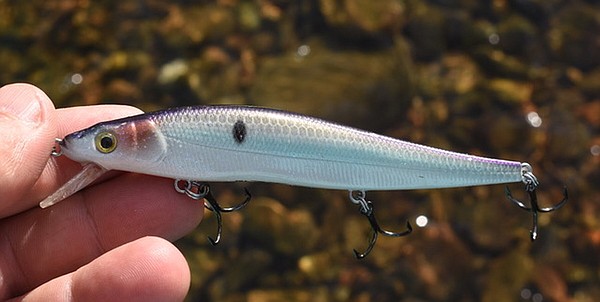With river flows low and gentle, now is a great time to chase trout with stickbaits in the tailwaters below our Ozark reservoirs.
Properly trolling a stickbait requires precision. Our favorite stickbaits are about 3 1/2 -4 inches long, with slender bodies and sleek tapers. The floating Rapala is a traditional favorite that always catches fish. My favorite is a Rick Clunn Luck-E-Strike in a blue herring color with a chartreuse belly and a herringbone pattern on the flanks. I can’t say scientifically that it outcatches any other style and color, but I will say it anecdotally.
We are also very fond of the Lucky Craft Pointer in rainbow trout pattern. Big brown trout love to eat tiny rainbow trout, and big rainbows are cannibalistic, too. Brown and rainbow trout patterns also excel with Rapala.
You need a big lure like that when trolling in even moderate current. If current is low and slow, you can do very well with much smaller stickbaits, like those made by Trout Magnet. Heavy current overwhelms smaller lures and ruins their actions. It also pushes small lures to the surface and away from the fish.
For trolling, you want a long, light-action or medium-light action spinning rod and a reel spooled with 6-pound test line. I often tie about 24 inches of flourocarbon leader to allow the lure to dive a little deeper.
Boat speed is the key to successful trolling. You want to move the boat upstream slightly faster than the current coming downstream. This requires precise motor control, much of which depends on the motor itself. A 9.9-horsepower motor is about perfect in all water, with 15-horsepower being near the upper limit. Anything larger goes too fast except in heavy current, when you can get by with 25-horsepower.
With the bow pointed upstream, cast your stickbait behind the boat and let out enough line to allow the lure to trail about 30-35 yards behind the boat. If there are two anglers, they should troll from opposite sides.
With the helmsman working upstream through the deepest, rockiest holes, you should feel the lure wobbling through your line. You can feel it better by wedging the rod handle against your thigh. David Fritts and other bass anglers on North Carolina’s highland Piedmont lakes made the “thigh technique” famous in the 1980s and 1990s when they perfected the art of using deep-diving crankbaits.
If the throb dampens or disappears, it’s because your lure has snagged a bit of moss. Reel it in immediately and clear the hooks.
Small to middle-size trout hit tentatively. You will usually feel three strikes before the fish commits. Every fish feels big in current, but a fish that gets hooked after multiple strikes will generally be smaller than 14 inches.
Big trout don’t mess around. They hit once, and they hit hard. They don’t hesitate like small trout do, either. Once hooked, a big trout races away. If the drag on your reel is too tight, it will break off.
If the drag is properly set, the fish will strip line off the reel at a very fast rate. The helmsman, noting which side the fish is on, will turn the boat accordingly to prevent cutting the line with the propeller. He will then hurry the boat to the fish at a speed that allows the angler to reel in slack.
If the helmsman goes too fast, the angler can’t keep up. This will create slack in the line and probably result in the fish getting free.
Once the helmsman catches up to the fish, the angler can settle in for the fight. The helmsman must keep track of the fish. If it courses across the stern, he must disengage the propeller immediately to keep it from severing the line.
Repeated fights will stress line close to the lure. Wood and rock will abrade line, as well. Anglers must check their line frequently and retie.
Wade fishing
If you don’t have a boat or if water is too low for boating, casting and retrieving jerkbaits while wade fishing is a fantastic way to catch trout.
I learned this in the 1990s when I frequently fished the Beaver Tailwaters. Jerk-retrieving a large floating Rapala was a consistently effective way to catch a lot of trout, and also big brown trout. I frequently caught big browns and rainbows following fly fishermen that worked over the same cover thoroughly. One of my most memorable was a large brown that followed the lure to my shins. When I lifted the lure from the water, its snout almost touched my waders, as if it were daring me to throw it again. I did. When that lure hit the water, the trout went after it like a Labrador retriever chasing a bumper. I caught that fish.
When jerking stickbaits, it’s important to move slowly and fan cast every inch of water you can reach. Experiment with your retrieves. Sometimes trout will hit a lure lying still on the surface. Sometimes they prefer a slow, steady retrieve. Other times they’ll ignore everything except a frenetic retrieve. Cast to the same spot multiple times and use all of the retrieves.
I prefer to cast downstream because current will push the lure deeper and impart some extra action as you retrieve upstream. However, trout feed by facing upstream and eating things coming downstream. A wounded, struggling baitfish coming downstream in front of their eyes is a more natural presentation, and they often can’t resist it.
When wading, you won’t be able to run down a big trout. You will have to adjust your drag in mid fight to control it. For unmanageable fish, you might have to run or get on the bank and follow it. Interesting things can happen when running among rocks and gravel in waders and heavy wading boots. None of them are good.
Taking spills is part of the experience, and if you land a monster brown, it’s worth the discomfort and embarrassment.
Credit: Source link































